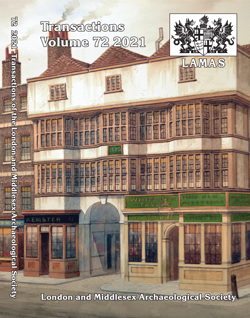Transactions of the London & Middlesex Archaeological Society
Volume 72 - 2021
The articles will become available for download in December 2025
List of Contents
Derek Keene a tribute to his prolific study of medieval London
We remember a past president of LAMAS, an inspired medieval historian and polymath.
Roman lead-alloy spoons from London: a new corpus Rachel S. Cubitt
A recently discovered late Roman lead-alloy spoon from Sugar Quay in the City of London has provided the impetus to reappraise the London corpus of this unusual type of cutlery.
An early 5th-century coin hoard from London’s Northern Cemetery: Principal Place, Hackney Julian M C Bowsher
A significant hoard of Roman gold and silver coins, the latest dated to AD 397–402, was buried in an extramural cemetery in Shoreditch.
Excavations at Alderman’s House 117, 119, 121 Bishopsgate and 34-37 Liverpool Street, London EC2 Alistair Douglas
Excavations just outside the walled city revealed evidence of human activity spanning from the prehistoric period to the 20th century. The earliest activity consisted of worked flints, there were numerous early Roman quarry pits and six inhumation burials including an adolescent interred in a lead coffin. The site was apparently abandoned by c.AD 400 and not reoccupied until 1050–1200, when numerous cess and rubbish pits were dug, which are interpreted as back yard activity linked with suburban properties fronting onto the western side of Bishopsgate. The earliest evidence of buildings on site consisted of a brick-built vaulted cellar of either 16th or 17th century date, below the White Hart Tavern (documented by 1545). Later structural evidence included the basements of No 117–121 Bishopsgate.
Roman backyards, Tudor mansions, post-medieval burials and an East India Company warehouse: Excavations at Walsingham House, Seething Lane in the City of London, EC3 Les Capon and Helen Chittock
Excavations inside the walled city revealed Roman backyards, medieval rubbish and cess pits, fragments of brick-built upmarket Tudor mansions (Sir Francis Walsingham, principal secretary to Elizabeth I from 1573 until 1590 lived locally), part of the post-medieval burial ground of St Olave’s parish church, and a tiny portion of a monumental complex of East India Company warehouses. This sequence of activity shows how the character of this area of the City has dramatically changed over the last 2000 years.
West Ham’s development from medieval village to London suburb: excavations at 48 Church Street, London E15 Peter Rowsome
It is easy to forget that the metropolitan sprawl of Greater London incorporates all manner of rural medieval settlements, which only survive today as place-names. This article looks at the material culture of one of these largely forgotten communities and charts its urbanisation.
Activity on the Edge of Lundenwic: Excavations at Parker House, London Borough of Camden, London Ian Hogg
The site lies within the Middle Saxon settlement of Lundenwic and the earliest features found on site date to this period. The activity primarily comprised gravel quarrying within an area demarcated by ditches and spanned the later 8th and early 9th centuries AD.
Richard Whittington and the Brewers of London 1419-22 Caroline Metcalf
Dick Whittington is best known today as a pantomime character, instead of being of Lord Mayor of London three times (1397,1406 and 1420). We now know he was not a favourite of the one of the City of London leading livery companies: the Brewers or as they say in panto ‘oh no he wasn't!’
A Newly discovered survey of Ralph Treswell: water, entertainment and the Seckford estate in Clerkenwell Eva Griffith
This previously unknown survey provides some exciting new information on the Red Bull Theatre. It was established in 1600, renovated in 1625 and visited by the diarist Samuel Pepys in 1661 shortly before it closed.
The Clitherow workshop ‘at the Corner of Old Bethlem gate, next Morefield’: evidence for late 17th- and early 18th-century bone and ivory working from the New Churchyard, London EC2 Rachel Cubbit, Robert Hartle and Michael Marshall
More than 4000 fragments of bone and ivory working waste were recovered during the archaeological excavation of the New Churchyard burial ground for Crossrail in advance of the construction of the new Broadgate ticket hall, next to Liverpool Street Station. The waste probably derives from a workshop owned by successive generations of the Clitherow family who also served as keepers of the burial ground between 1636 and1740 and who appear to have disposed of much of their waste within its limits.
Household assemblages discarded by Moorfields brokers: material culture in 18th-century London EC2 Robert Hartle, Nigel Jeffries and Jacqui Pearce
The late 18th-century finds assemblages recovered from two cesspits excavated in modern Blomfield Street in the City of London, provide illuminating insights into the lives of the street’s former residents.
Various newly published archaeological and historical publications are reviewed including:
- In the Northern Cemetery of Roman London: excavations at Spitalfields Market, London E1, 1997-2007 (MoLA monograph 58)
- Elite Residence to Manufacturing Centre: excavations at Price’s Candle Factory, Regent and Grove Wharves and Bridges Wharf, Battersea (PCA monograph 22)
- London’s Roman Tools; craft, agriculture and experience in an ancient city (BAR B663)
- Thomas Kytson’s ‘boke of remembrance’ 1529 to 1540 (London Record Society)


